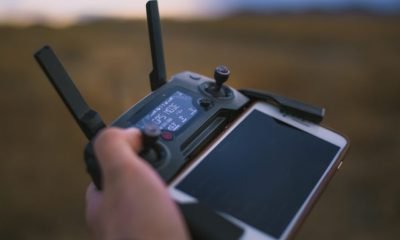Drone Technology
Drone Materials & Design
Published
6 months agoon
Table Of Contents

Drone Materials & Design – Unveiling the Engineering Behind UAVs
In this article, we’ll explore the fascinating world of drone materials and design. From the cutting-edge composites that make drones lighter and faster to the aerodynamic principles that keep them stable in flight, we’ll uncover the science and innovation behind these modern marvels.
Have you ever wondered what makes drones soar gracefully through the skies, defying gravity with precision and speed? The answer lies in a seamless blend of advanced materials and thoughtful design principles. Whether it’s the lightweight frame of a racing drone or the rugged build of an industrial UAV, every material and design choice directly impacts its performance, durability, and functionality. Join us as we delve into how material selection and engineering shape the drones of today and set the stage for the possibilities of tomorrow.
Article Guide: Drone Materials & Design
- Key Drone Materials
- Drone Design Principles
- Material-Design Interplay
- Innovations in Drone Materials and Design
- Practical Considerations for Consumers
- Future of Drone Materials & Design
Key Drone Materials
The materials used in drone construction are the unsung heroes behind their remarkable performance and versatility. From lightweight racing drones that zip through the air with agility to heavy-duty industrial drones capable of carrying substantial payloads, the choice of materials plays a defining role in their design and capabilities.
Each material contributes specific properties that address the unique challenges of flight, such as maintaining stability, optimizing battery life, and withstanding harsh environmental conditions. Whether it’s the strength of carbon fiber, the versatility of aluminum alloys, or the flexibility of advanced plastics, every component is carefully selected to balance durability, weight, and cost.
In this section, we’ll explore the most commonly used materials in drone construction, highlighting their properties, applications, and the advantages they bring to the skies. Understanding these materials provides a glimpse into the intricate engineering that makes modern drones possible.

Carbon Fiber: The Lightweight Champion of Drone Materials
Carbon fiber is one of the most commonly used materials in drone construction, and for good reason. Known for its exceptional strength-to-weight ratio, carbon fiber allows drones to achieve unparalleled performance in terms of speed, agility, and durability. This material is a composite made of thin, strong crystalline filaments of carbon, woven into a fabric and combined with a resin to form a rigid structure. The result is a material that is both incredibly light and remarkably strong, making it an ideal choice for critical components in drone construction.
Properties of Carbon Fiber
The defining characteristic of carbon fiber is its strength relative to its weight. It is significantly lighter than metals like aluminum yet offers superior tensile strength. Additionally, it is resistant to corrosion, ensuring longevity even in harsh environmental conditions. Its rigidity prevents warping under stress, a crucial factor in maintaining stability and structural integrity during flight.
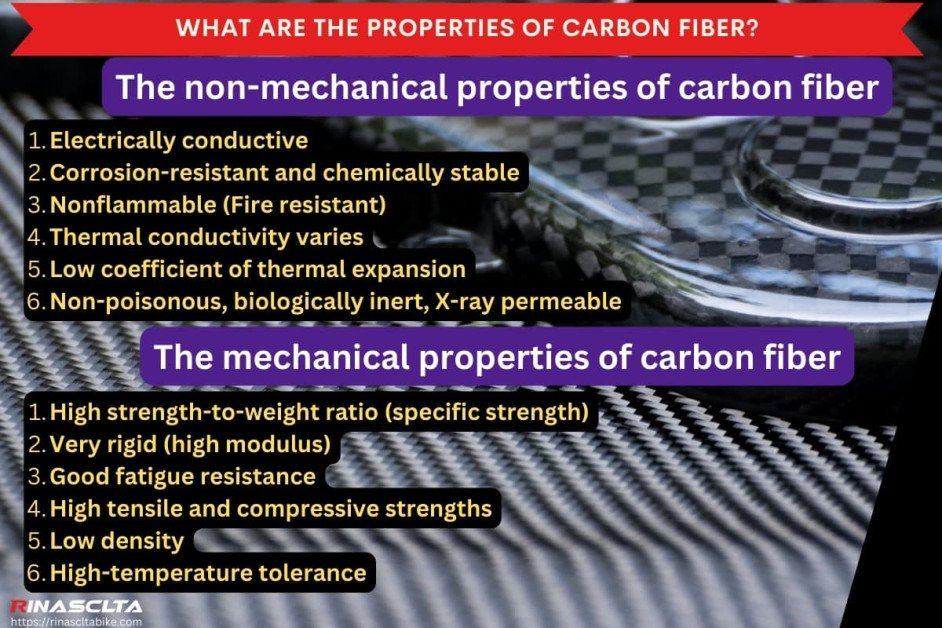
Applications in Drone Construction
Carbon fiber’s properties make it versatile for a range of applications within a drone’s design:
- Frames: The primary use of carbon fiber in drones is for building the main frame. A carbon fiber frame provides the structural backbone, offering a lightweight yet robust platform to house other components. This minimizes overall weight while maximizing durability, which is particularly important for racing and aerial photography drones.
- Propeller Blades: Another significant application is in the construction of propeller blades. Carbon fiber blades are not only lightweight but also rigid, reducing vibration and increasing efficiency during flight.
- Reinforced Components: Carbon fiber is often used to reinforce key structural elements, such as motor mounts and arms, to enhance overall strength without adding unnecessary weight.
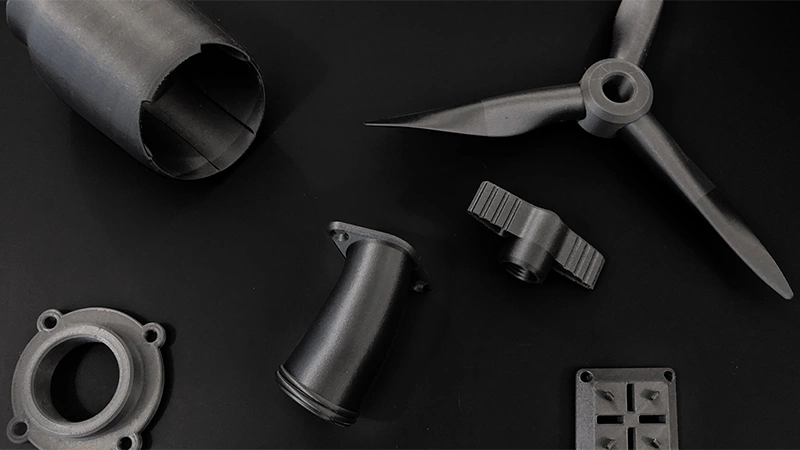
Advantages of Carbon Fiber
The advantages of using carbon fiber in drones are numerous:
- Lightweight Design: Reducing the weight of a drone directly impacts its flight time and energy efficiency. Carbon fiber’s lightness ensures the drone consumes less power, extending battery life and increasing operational range.
- Enhanced Durability: Carbon fiber is highly resistant to impact, making drones more resilient in the event of a collision. This durability also translates to lower maintenance costs over time.
- Heat Resistance: Carbon fiber’s ability to withstand high temperatures makes it suitable for drones with high-performance motors or electronic components that generate significant heat.
- Improved Maneuverability: A lightweight frame allows drones to achieve greater speed and agility, particularly valuable for racing drones or those performing complex aerial maneuvers.
Limitations of Carbon Fiber
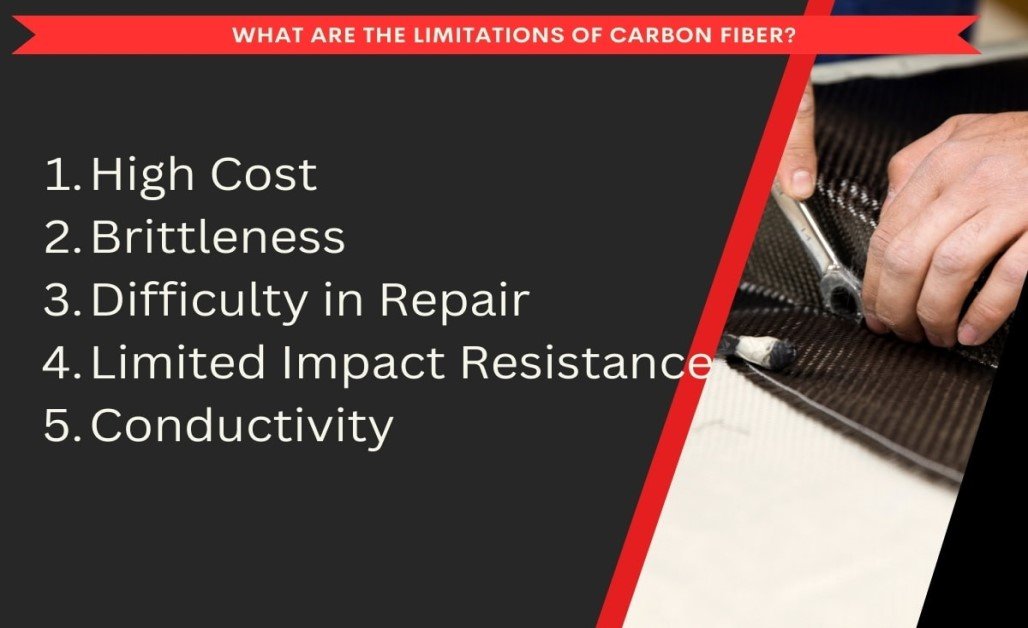
Despite its many benefits, carbon fiber does have some limitations. It is relatively expensive compared to other materials, which can increase the overall cost of the drone. Additionally, while it is strong, its rigidity can make it prone to cracking under extreme stress or sharp impacts, unlike more flexible materials like plastic.
Why Carbon Fiber Matters
Carbon fiber represents the pinnacle of performance-focused material choice in drone engineering. Its combination of strength, lightness, and durability enables drones to push the boundaries of what is possible in both recreational and commercial applications. Whether it’s a high-speed racing drone or a professional aerial photography UAV, carbon fiber ensures that the craft performs at its best, withstanding the demands of modern flight.
Aluminum Alloys: The Versatile Backbone of Drone Materials

Aluminum alloys are another essential material in drone construction, prized for their balance of lightweight properties, strength, and affordability. Composed of aluminum combined with other elements like magnesium, silicon, or copper, these alloys are engineered to enhance strength and resistance to corrosion while maintaining aluminum’s naturally low weight. This combination makes them an excellent choice for drones that require durability without compromising on flight efficiency.
Properties of Aluminum Alloys
Aluminum alloys are characterized by their versatility and durability. While aluminum alone is relatively soft, combining it with other metals produces an alloy that retains its lightweight nature but is significantly stronger and more resilient. Additional properties like excellent thermal conductivity and resistance to corrosion make aluminum alloys ideal for drones operating in a variety of environments, from humid coastal areas to arid deserts.

Applications in Drone Construction
Aluminum alloys are widely used in several key areas of drone design:
- Arms: Aluminum alloy arms provide a sturdy yet lightweight framework to connect the motors and propellers to the drone’s body. This ensures stability during flight while keeping the overall weight manageable.
- Motor Mounts: Motor mounts made from aluminum alloys offer a strong foundation to house the motors, reducing vibrations and improving flight performance. The material’s rigidity ensures that motors remain securely in place, even during high-speed maneuvers.
- Heat Sinks: Aluminum’s high thermal conductivity makes it an excellent material for heat sinks, which dissipate heat generated by electronic components such as motors, batteries, and control systems.
Advantages of Aluminum Alloys
The use of aluminum alloys in drones provides several key advantages:
- Lightweight Strength: Aluminum alloys are strong enough to withstand stress and impacts while remaining lighter than most other metals, helping to reduce overall drone weight.
- Corrosion Resistance: The natural oxidation layer on aluminum alloys prevents rust, ensuring durability in challenging weather conditions or environments with high moisture content.
- Affordability: Compared to advanced materials like carbon fiber, aluminum alloys are more cost-effective, making them a popular choice for both consumer-grade and professional drones.
- Ease of Machining: Aluminum alloys are easy to shape and machine, allowing for precise construction of drone components. This adaptability also enables manufacturers to create complex designs with minimal effort.
Limitations of Aluminum Alloys
While aluminum alloys offer numerous benefits, they do have some limitations. They are not as light or as strong as carbon fiber, which can limit their use in ultra-light or high-performance drones. Additionally, they can dent or deform under extreme stress, which may require frequent inspections and occasional replacements in demanding applications.
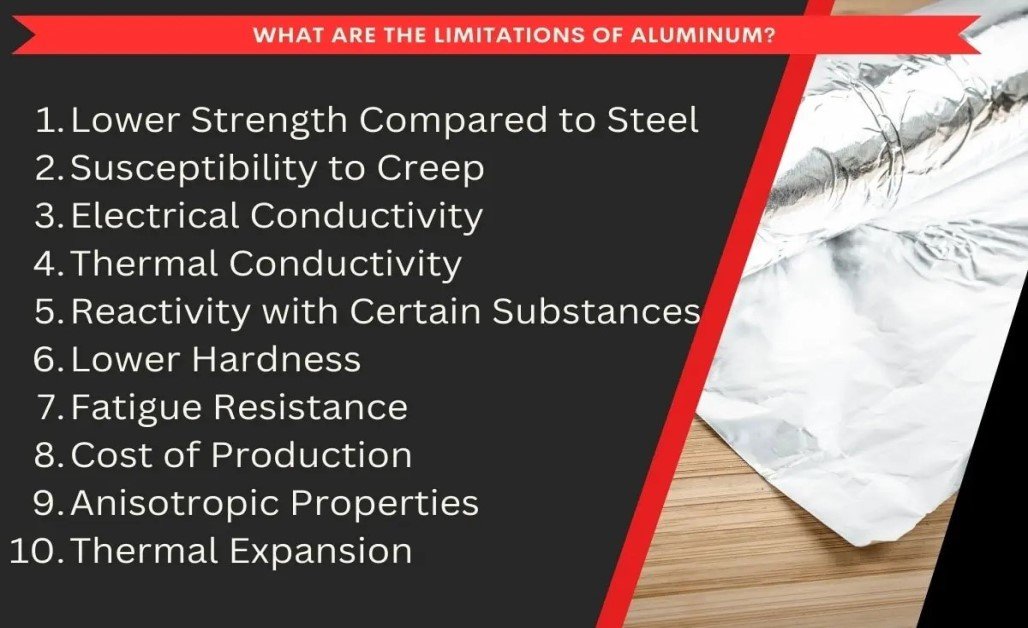
Why Aluminum Alloys Matter
Aluminum alloys serve as the backbone of many drones, particularly those designed for general-purpose use or commercial applications. Their unique combination of strength, weight, and cost-efficiency allows drones to operate reliably in a wide range of environments. Whether used in small consumer drones for hobbyists or larger industrial UAVs for delivery and inspection tasks, aluminum alloys provide a robust and adaptable material solution.
With their excellent heat dissipation, resistance to environmental factors, and ability to support heavy payloads, aluminum alloys are a versatile choice that ensures drones are both capable and reliable. Their affordability also makes advanced drone technology more accessible to a broader range of users.
Plastics and Composites: The Flexible and Affordable Building Blocks
Plastics and composites are essential materials in drone construction, offering an impressive balance of cost, flexibility, and durability. These materials are particularly popular for consumer and hobbyist drones but are also widely used in professional models for specific components. With advances in materials science, modern plastics and composites are becoming increasingly strong, lightweight, and versatile, making them indispensable for a variety of drone applications.

Properties of Plastics and Composites
Plastics like ABS (Acrylonitrile Butadiene Styrene), polycarbonate, and nylon are valued for their impact resistance, flexibility, and ease of manufacturing. When combined with reinforcements such as fiberglass or carbon fiber, they become composites that significantly improve their strength and durability while retaining their lightweight nature. These properties make plastics and composites highly adaptable to complex shapes and intricate designs.
Applications in Drone Construction
The versatility of plastics and composites allows them to serve multiple roles in drone design:
- Protective Casings: Plastics are commonly used for the outer shell of drones, protecting internal electronics from environmental factors like dust, moisture, and minor impacts. ABS, for example, is a popular choice for its toughness and affordability.
- Landing Gear: The flexibility of plastics makes them ideal for constructing landing gear, which needs to absorb shocks during takeoff and landing. Nylon-based composites are often used to ensure strength while maintaining a lightweight structure.
- Propeller Guards: Plastics and composites are also employed in propeller guards, which help prevent damage to the blades and enhance safety during operation.
- 3D-Printed Components: Advances in 3D printing technology have made it possible to create custom plastic components for drones quickly and cost-effectively. This is particularly useful for prototyping or specialized applications.
Advantages of Plastics and Composites
Plastics and composites provide numerous benefits in drone construction:
- Affordability: Compared to materials like carbon fiber or aluminum, plastics are much more cost-effective, making them ideal for mass production and budget-friendly drone models.
- Ease of Manufacturing: Plastics can be molded into complex shapes, allowing for seamless and aerodynamic designs. This also enables rapid production of intricate parts.
- Impact Resistance: While not as rigid as carbon fiber, the flexibility of plastics helps them absorb impacts without breaking, making them suitable for components subject to frequent stress.
- Lightweight Nature: Plastics and composites are light enough to keep the drone agile and energy-efficient, especially for smaller consumer drones.
Limitations of Plastics and Composites
Despite their advantages, plastics and composites have limitations that must be considered. They are generally less durable than metals or carbon fiber, particularly in extreme conditions. Prolonged exposure to UV radiation or high temperatures can cause some plastics to degrade or lose strength. Additionally, they may not provide the rigidity needed for high-performance drones or heavy payloads.

Why Plastics and Composites Matter
Plastics and composites are the workhorses of drone manufacturing, offering an affordable and versatile material option for a wide range of applications. They are particularly beneficial for consumer drones, where cost and ease of manufacturing are critical considerations. Their adaptability also makes them valuable in professional drones for non-structural components that prioritize flexibility and impact resistance.
With advancements in materials science, reinforced composites are narrowing the performance gap between plastics and more premium materials like carbon fiber. This ensures that plastics and composites will continue to play a pivotal role in making drones accessible and reliable for users at all levels.
Magnesium Alloys: The Lightweight Powerhouses of Drone Design
Magnesium alloys are a rising star in the world of drone construction, offering a unique combination of lightweight properties and remarkable strength. As one of the lightest structural metals, magnesium is alloyed with elements like aluminum, zinc, and manganese to enhance its strength, corrosion resistance, and thermal properties. These characteristics make magnesium alloys particularly appealing for high-performance drones where weight and durability are critical.
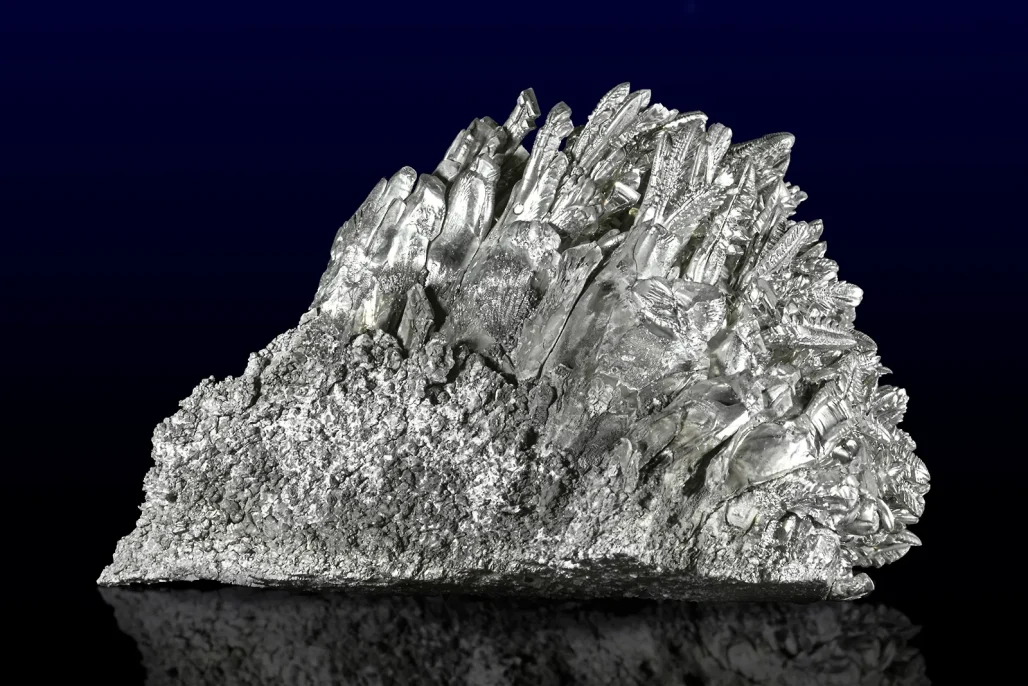
Properties of Magnesium Alloys
Magnesium alloys stand out for their exceptional lightness, being about 30% lighter than aluminum. Despite their low density, they maintain impressive strength and rigidity, making them suitable for demanding applications. Additionally, they possess excellent thermal conductivity and resistance to deformation under high temperatures, which is vital for drones operating in extreme environments or carrying high-power electronics.
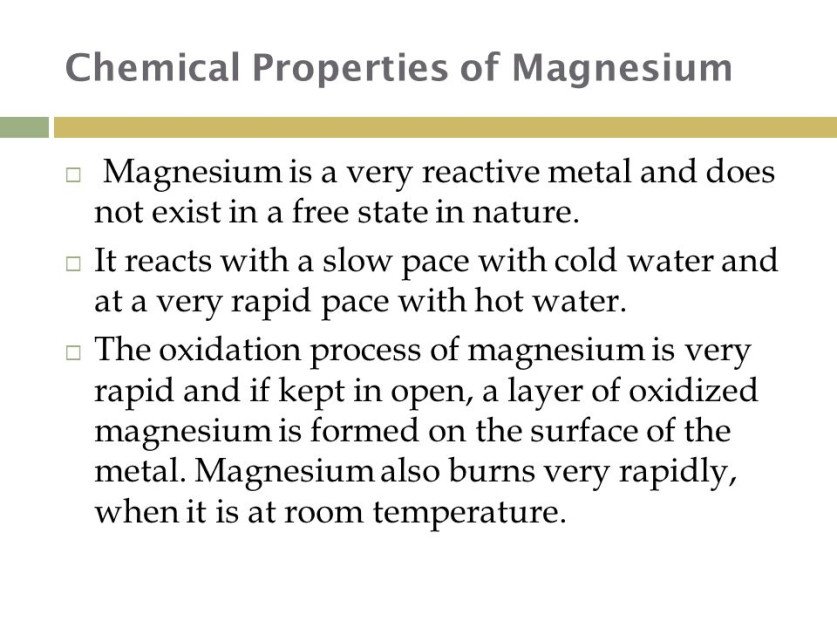
Applications in Drone Construction
Magnesium alloys are used in key areas of drone construction where their unique properties can be fully utilized:
- Structural Components: Magnesium alloys are commonly used in drone frames and arms to reduce weight while maintaining structural integrity. This is especially advantageous in drones designed for extended flight times or high payload capacities.
- Motor Housings: The lightweight and heat-resistant nature of magnesium alloys makes them ideal for motor housings, where they help dissipate heat generated during operation.
- Heat Sinks: Given their excellent thermal conductivity, magnesium alloys are used as heat sinks to manage the heat produced by high-performance electronics and batteries.
- Custom Components: The machinability of magnesium alloys allows for the creation of intricate and specialized parts, catering to drones designed for niche applications like thermal imaging or high-altitude inspections.
Advantages of Magnesium Alloys
Magnesium alloys offer a host of benefits for drone construction:
- Lightweight Efficiency: By significantly reducing the weight of critical components, magnesium alloys contribute to longer flight times, improved maneuverability, and increased energy efficiency.
- High Strength-to-Weight Ratio: These alloys are strong enough to handle the stresses of flight while keeping weight at a minimum, making them suitable for both recreational and professional drones.
- Thermal Performance: Magnesium alloys effectively dissipate heat, preventing overheating of motors and other critical components during intense operations.
- Corrosion Resistance: Modern magnesium alloys are treated to resist corrosion, making them durable even in challenging environments such as marine or industrial settings.
- Eco-Friendly Manufacturing: Magnesium is one of the most abundant elements on Earth, and its alloys are relatively eco-friendly to produce compared to other metals.
Limitations of Magnesium Alloys
While magnesium alloys have many strengths, they also have some limitations. They are more expensive than standard aluminum alloys, which can increase production costs. Additionally, magnesium is more prone to scratching and surface damage, requiring protective coatings or treatments to enhance its longevity. In applications involving very high loads or impacts, magnesium alloys may not match the strength of carbon fiber or titanium.
Why Magnesium Alloys Matter
Magnesium alloys are revolutionizing drone design by offering a lightweight and robust alternative to traditional materials. Their ability to combine strength, thermal performance, and machinability makes them a preferred choice for high-performance and specialized drones. From lightweight racing drones to industrial UAVs designed for extended operations, magnesium alloys provide the perfect balance of performance and efficiency.
As the demand for drones with longer flight times and higher payload capacities grows, magnesium alloys are poised to play an even larger role in the evolution of drone technology. Their unique properties and adaptability ensure that they remain at the forefront of innovative drone engineering.
Other Advanced Materials: Pushing the Boundaries of Drone Materials
While carbon fiber, aluminum, plastics, and magnesium alloys dominate drone construction, other advanced materials are increasingly being explored to meet specialized needs. These materials often address specific challenges like weight reduction, durability, conductivity, or environmental sustainability. Let’s delve into some of these innovative materials shaping the future of drone design.
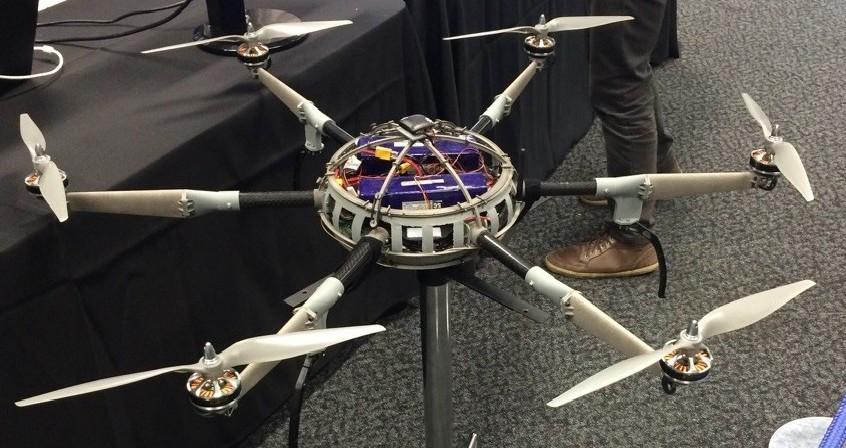
Titanium: Extreme Strength and Resilience
Titanium is renowned for its exceptional strength-to-weight ratio and resistance to corrosion, making it a premium choice for components requiring durability under stress. While heavier than aluminum or magnesium, titanium’s superior strength allows for thinner, lighter components without compromising performance.
- Applications:
- Fasteners and joints: Titanium is commonly used in areas subjected to significant stress, such as the connections between arms and frames.
- Landing gear: Its impact resistance makes it suitable for rugged drone designs.
- Advantages:
- High resistance to corrosion, ideal for drones used in marine or industrial environments.
- Exceptional durability under high-stress conditions.
- Limitations: High cost and difficulty in machining limit its widespread use.
Graphene: The Material of the Future
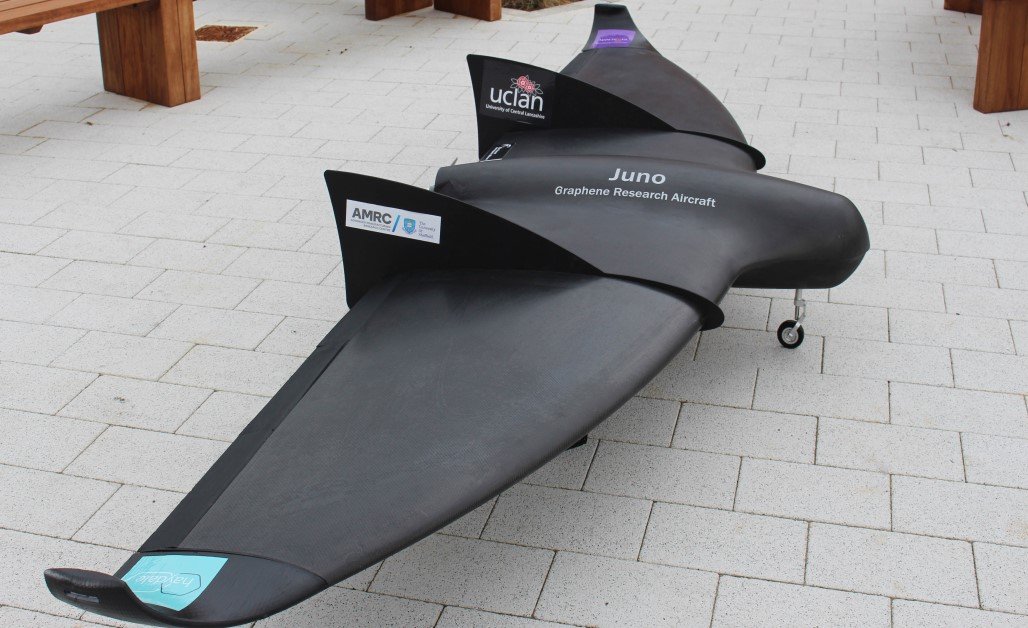
Graphene, a single layer of carbon atoms arranged in a hexagonal lattice, has gained attention as a revolutionary material due to its unmatched strength, lightweight properties, and electrical conductivity. Though still in the experimental phase for drones, graphene holds tremendous potential.
- Applications:
- Batteries: Graphene-based batteries promise faster charging times and longer flight durations.
- Lightweight frames: When combined with resins, graphene can produce ultra-lightweight and durable composites.
- Advantages:
- Exceptional strength and lightweight nature.
- High electrical and thermal conductivity for efficient energy management.
- Limitations: High production costs and limited availability hinder its commercial adoption.
3D-Printed Polymers: Customization and Precision
3D printing has revolutionized the way drone components are designed and manufactured. Using advanced polymers such as carbon-reinforced nylon, drones can now be constructed with precision and tailored to specific applications.
- Applications:
- Custom frames and housings: 3D printing enables rapid prototyping and the creation of intricate, lightweight structures.
- Replacement parts: Damaged components can be quickly replaced with 3D-printed parts, reducing downtime.
- Advantages:
- Cost-effective for small-scale production or prototyping.
- Allows for innovative and complex designs that traditional manufacturing cannot achieve.
- Limitations: Lower strength compared to traditional materials, making 3D-printed parts more suitable for non-structural components.
Ceramics and Ceramic Composites: High-Temperature Performance
Advanced ceramics are gaining traction in drone construction, particularly for components that experience extreme heat. Ceramic composites combine the properties of ceramics with other materials to enhance their durability and flexibility.
- Applications:
- Heat shields: Protect electronics from extreme temperatures in high-performance drones.
- Bearings: Reduce friction and improve the efficiency of moving parts.
- Advantages:
- Excellent resistance to heat and wear.
- Lightweight yet durable.
- Limitations: Fragility and high production costs limit their broader application.
Biodegradable Materials: The Eco-Friendly Frontier
As environmental sustainability becomes a priority, biodegradable materials are being explored for drone construction. These materials, often derived from plant-based sources, provide a greener alternative to traditional plastics.
- Applications:
- Single-use drones: Used in disaster relief or military operations where recovery isn’t feasible.
- Casing and housings: Biodegradable options reduce environmental impact.
- Advantages:
- Environmentally friendly and sustainable.
- Potential to reduce waste in disposable drone applications.
- Limitations: Limited durability and strength compared to conventional materials.
Why Advanced Materials Matter
Advanced materials push the boundaries of what drones can achieve, opening up possibilities for greater efficiency, functionality, and sustainability. While many of these materials are still emerging, their unique properties allow for specialized solutions that traditional materials cannot provide. From ultra-lightweight frames to eco-friendly components, these innovations are setting the stage for the next generation of drones.
Drone Design Principles
What makes a drone capable of steady flight, precise maneuvers, and efficient operation? The answer lies in its design principles. A drone’s design is more than just aesthetics—it’s a carefully engineered balance of aerodynamics, structural integrity, weight distribution, and thermal management. Each principle plays a vital role in determining how a drone performs, how efficiently it consumes energy, and how well it adapts to various environments and tasks.
Drone design is a multidisciplinary challenge, requiring insights from physics, materials science, and engineering. From the sleek contours that reduce drag to the reinforced frames that withstand high stress, every design choice contributes to the overall functionality and reliability of the drone. As drones continue to evolve, these principles are being refined to push the boundaries of performance, enabling them to fly faster, carry heavier payloads, and endure harsher conditions.
In this section, we’ll delve into the foundational principles that guide drone design, exploring how aerodynamics, structural considerations, and thermal management work together to create machines that are not only functional but also highly efficient and adaptable. Understanding these principles provides a glimpse into the art and science of crafting drones that excel in diverse applications, from recreational flying to industrial inspections.
Aerodynamics: Minimizing Drag and Maximizing Flight Efficiency
Aerodynamics is a cornerstone of drone design, determining how efficiently a drone moves through the air and handles various flight conditions. By minimizing air resistance, also known as drag, and optimizing lift, drones can achieve greater stability, speed, and energy efficiency. A well-designed aerodynamic profile is essential for enhancing flight performance, extending battery life, and ensuring smooth operation across diverse environments.

Key Features of Aerodynamic Design
Streamlined shapes are critical for reducing drag and enabling smoother airflow around the drone’s frame. These shapes ensure that air moves past the drone with minimal resistance, allowing it to consume less energy during flight. Compact, low-profile designs are particularly effective in windy conditions, as they reduce the surface area exposed to air resistance.
Propeller design plays an equally important role in aerodynamics. Propellers are not just rotating blades—they are carefully engineered airfoils. Their size, pitch, and shape determine how much lift and thrust the drone can generate. Larger propellers with an optimal pitch provide better efficiency for heavy-lift drones, while smaller, high-speed propellers enhance maneuverability for racing drones.
A drone’s orientation, or how it cuts through the air, also affects its aerodynamic efficiency. Many drones incorporate design elements such as tilted arms or adjustable propeller angles to optimize airflow and reduce drag during high-speed operations.
Applications of Aerodynamics in Drone Design
Racing drones are a prime example of how aerodynamics enhances performance. These drones are designed with minimal drag to achieve high speeds and agile maneuvers. Their sleek frames and high-speed propellers maximize thrust while conserving energy.
Long-range drones, on the other hand, prioritize aerodynamic efficiency to extend flight times. By minimizing air resistance, these drones can cover greater distances on a single battery charge, making them ideal for applications like mapping, surveying, and delivery.
Advantages of Aerodynamic Design
An aerodynamic design significantly improves a drone’s energy efficiency. By reducing the energy lost to drag, drones can achieve longer flight times and operate more effectively in challenging conditions. This is particularly important for drones used in commercial applications, where extended operation is often a key requirement.
Enhanced stability is another benefit of aerodynamic design. A streamlined drone is less susceptible to turbulence and wind, ensuring smoother flight and more precise control. This is especially valuable for drones capturing high-quality imagery or conducting delicate inspections.
Aerodynamics also contributes to speed and agility, making drones capable of faster and more responsive movements. This is vital for competitive racing drones and those used in emergency response scenarios where time is critical.
Challenges in Aerodynamic Optimization
While aerodynamics offers significant advantages, it also introduces challenges. Designing a drone that is both aerodynamically efficient and structurally robust requires careful balancing. For example, adding features like landing gear or external payloads can increase drag, reducing overall efficiency. Engineers must carefully integrate these elements to minimize their impact on airflow.
The trade-off between aerodynamics and weight is another consideration. Streamlining often involves adding fairings or smooth surfaces, which can add weight. Designers must evaluate whether the aerodynamic benefits outweigh the additional mass.
Why Aerodynamics Matters
Aerodynamics is fundamental to drone performance, influencing everything from energy consumption to stability and maneuverability. A well-aerodynamic drone not only flies more efficiently but also delivers enhanced reliability and precision. Whether it’s a racing drone designed for speed, a commercial drone focused on endurance, or a recreational drone built for ease of use, aerodynamics ensures that every flight is as smooth and efficient as possible.
Structural Integrity: Balancing Strength and Weight
Structural integrity is at the heart of drone design, ensuring the craft can endure the physical stresses of flight, environmental challenges, and operational demands without compromising performance. A well-constructed drone must be strong enough to withstand impacts and vibrations yet light enough to maximize energy efficiency and maneuverability. This delicate balance between strength and weight defines the durability and reliability of drones across all applications.
Design Considerations for Structural Integrity
Reinforced frames are a cornerstone of structural integrity in drone design. Materials like carbon fiber, aluminum alloys, and magnesium alloys are commonly used to build the drone’s main frame. These materials provide a high strength-to-weight ratio, ensuring the frame remains rigid and durable while keeping overall weight to a minimum. Reinforcement is often concentrated in critical areas, such as the arms that support the motors and propellers.
Shock absorption is another key consideration. Components like landing gear and protective casings are designed to absorb impact forces during takeoffs, landings, or minor collisions. Flexible materials, such as nylon or reinforced plastics, are often used in these components to dissipate energy and reduce the risk of structural damage.
Modular designs enhance structural integrity by simplifying repairs and allowing for quick replacements. A modular frame can isolate damage to specific sections without compromising the entire structure, reducing maintenance costs and extending the drone’s operational lifespan.
Applications of Structural Integrity in Drone Design
Industrial drones used for inspections, mapping, or delivery often face harsh environments, such as high altitudes, extreme temperatures, or turbulent winds. Structural integrity is critical in these scenarios to ensure the drone operates safely and efficiently without succumbing to stress or wear.
Racing drones are another example, where structural integrity must accommodate high-speed impacts and intense vibrations. Lightweight yet rigid frames made of carbon fiber are commonly used to meet these demands, allowing racers to push their drones to the limit without fear of structural failure.
Camera drones rely on stable frames to minimize vibrations and maintain steady imagery. Structural integrity here is not just about strength but also about precision, as even minor distortions can affect the quality of the footage or images captured.
Advantages of Structural Integrity
A robust structure ensures the drone can endure physical stress, extending its operational life and reducing the frequency of repairs. This durability is particularly important for drones used in commercial and industrial applications, where downtime can result in significant costs.
Lightweight construction, achieved through structurally optimized designs, directly impacts flight efficiency. A lighter drone consumes less energy, allowing for longer flight times and improved performance, especially in scenarios involving heavy payloads or long-range missions.
Structural integrity also enhances safety by reducing the risk of component failure during operation. This is essential for drones flying in populated areas, near infrastructure, or carrying valuable equipment.
Challenges in Achieving Structural Integrity
Balancing strength and weight is a constant challenge in drone design. Over-reinforcing a drone can add unnecessary weight, reducing flight efficiency and maneuverability. Conversely, under-reinforcement can compromise the drone’s ability to handle stress, increasing the risk of damage or failure.
Another challenge lies in integrating structural integrity with other design elements, such as aerodynamics and modularity. For instance, adding modular components may introduce weak points that require additional reinforcement, potentially impacting the drone’s weight and efficiency.
Why Structural Integrity Matters
Structural integrity ensures that drones remain functional, reliable, and safe under varying conditions. From enduring the vibrations of high-speed flight to resisting impacts during landings, a well-designed structure is foundational to a drone’s success. Whether it’s a recreational drone built for casual use or an industrial UAV operating in extreme conditions, structural integrity guarantees that the drone can perform its intended tasks with confidence and resilience.
Weight Distribution: Ensuring Balance and Stability
Weight distribution is a critical aspect of drone design, directly affecting its stability, maneuverability, and overall performance. A well-balanced drone not only flies more smoothly but also optimizes energy consumption and extends battery life. By strategically positioning components like the battery, motors, and payload, designers ensure that the drone remains stable in flight and capable of handling a variety of tasks with precision.
How Weight Distribution Impacts Drone Performance
The distribution of weight in a drone influences how evenly the motors and propellers generate thrust. An imbalanced drone can exhibit uneven lift, which leads to instability, erratic movements, and increased energy consumption as the motors work harder to compensate for the imbalance. Proper weight distribution minimizes these issues, resulting in smoother flights, better control, and longer operational times.
For drones carrying payloads, such as cameras or delivery packages, weight distribution becomes even more crucial. Misplaced or unevenly distributed payloads can shift the drone’s center of gravity, causing it to tilt or struggle during flight. A carefully balanced design ensures that payloads are positioned to maintain equilibrium.
Optimizing Weight Distribution with Drone Materials
The choice of drone materials plays a vital role in achieving optimal weight distribution. Lightweight materials like carbon fiber, magnesium alloys, and reinforced plastics are often used to reduce the overall weight of the drone while maintaining structural integrity. These materials allow designers to allocate weight more efficiently, concentrating it in critical areas like the center of gravity without compromising durability or strength.
For example, batteries, one of the heaviest components in a drone, are typically placed close to the center of the frame. This central positioning ensures even weight distribution, preventing the drone from becoming tail-heavy or nose-heavy. Similarly, lightweight materials are used for the arms and outer frame to balance the heavier components without overburdening the motors.
Applications of Balanced Weight Distribution
Camera drones are a prime example of how weight distribution is optimized for specific tasks. To capture stable footage, the drone must remain balanced, even when carrying heavy cameras or gimbals. Designers achieve this by placing the camera system near the center of gravity and using lightweight materials for the frame to offset the added weight.
Delivery drones also rely on precise weight distribution to handle varying payload sizes and shapes. Adjustable compartments or modular designs are often used to accommodate different payloads without disrupting the drone’s balance.
In racing drones, weight distribution is optimized for agility and speed. Lightweight materials are used throughout the frame to keep the drone nimble, while the motors and battery are positioned to achieve rapid directional changes without losing stability.
Challenges in Weight Distribution
Achieving perfect weight distribution is not without challenges. Designers must account for dynamic changes, such as shifting payloads or fluctuating battery levels during flight. These changes can alter the drone’s center of gravity, affecting stability and control. To mitigate this, advanced drones are equipped with software and sensors that automatically adjust motor output to compensate for imbalances in real-time.
Another challenge is integrating modular or interchangeable components without disrupting weight distribution. For instance, adding a new payload or swapping a battery must be done carefully to ensure the drone remains balanced and functional.
Why Weight Distribution Matters in Drone Design
Weight distribution is integral to the functionality and efficiency of drones. Properly balanced drones consume less energy, fly more smoothly, and handle payloads with greater precision. By combining thoughtful design with lightweight and durable drone materials, manufacturers create drones that are not only stable but also versatile enough to adapt to diverse applications.
Heat Dissipation: Managing Thermal Challenges in Drone Design
Heat dissipation is a crucial factor in drone design, ensuring that the electronic components, motors, and batteries remain within safe operating temperatures during flight. High-performance drones generate significant amounts of heat, especially during extended operations, heavy payload use, or high-speed maneuvers. Effective thermal management prevents overheating, maintains efficiency, and extends the lifespan of the drone’s components.
How Heat Affects Drone Performance
Excessive heat can compromise the performance and durability of critical components. Overheated motors may lose efficiency, resulting in reduced thrust and shorter flight times. Similarly, batteries exposed to high temperatures can experience faster degradation, leading to diminished capacity and increased risk of failure. For drones carrying sensitive electronics, such as cameras or thermal imaging sensors, proper heat management is essential to ensure accurate and reliable performance.
Techniques for Heat Dissipation in Drones
- Material Selection: The choice of materials plays a vital role in heat management. Metals like aluminum and magnesium alloys are excellent conductors of heat and are commonly used in motor housings and heat sinks. These materials help draw heat away from critical components and dissipate it into the surrounding air.
- Ventilation and Cooling Systems: Many drones incorporate air vents, strategically placed to enhance airflow over heat-generating components. In high-performance or industrial drones, active cooling systems, such as small fans, may be used to supplement passive ventilation.
- Component Placement: Proper spacing and placement of components can reduce thermal buildup. Separating heat-generating components, such as motors and batteries, minimizes the risk of localized overheating and ensures more uniform temperature distribution.
- Heat Sinks: Heat sinks, typically made of aluminum or copper, are often attached to high-temperature components like motors or processors. These devices increase the surface area for heat dissipation, allowing the heat to disperse more efficiently.
- Thermal Insulation: In drones operating in extreme conditions, thermal insulation materials are used to protect sensitive components from external heat sources, such as direct sunlight or high ambient temperatures.
Applications of Heat Dissipation in Drone Design
Industrial drones often operate in demanding environments where effective heat dissipation is critical. For example, drones used for mapping or surveying in hot climates must manage prolonged exposure to high temperatures without affecting their electronics or batteries.
Racing drones, which are built for speed and agility, generate significant heat due to the high rotational speeds of their motors. Efficient heat dissipation ensures that these drones maintain peak performance during intense competition.
Camera drones equipped with advanced imaging systems or thermal cameras rely on heat dissipation to protect their sensors and processors, ensuring consistent performance and image quality.
Challenges in Heat Dissipation
Balancing heat management with weight and size constraints is a significant challenge. While adding heat sinks or cooling systems can improve thermal performance, these additions may increase the drone’s overall weight, affecting flight efficiency and agility. Designers must find the right balance between thermal management and other performance factors.
Another challenge is maintaining heat dissipation in compact drones. Smaller drones have less surface area for heat sinks and ventilation, making it more difficult to manage high temperatures. Advanced materials and design innovations are often needed to address these constraints.
Why Heat Dissipation Matters in Drone Design
Effective heat dissipation is essential for the safe and reliable operation of drones. By keeping critical components cool, manufacturers can ensure that drones perform consistently, even in challenging conditions. Proper thermal management not only extends the lifespan of components but also enhances overall efficiency, allowing drones to operate for longer periods and with greater precision.
Material-Design Interplay: How Materials Shape Drone Engineering
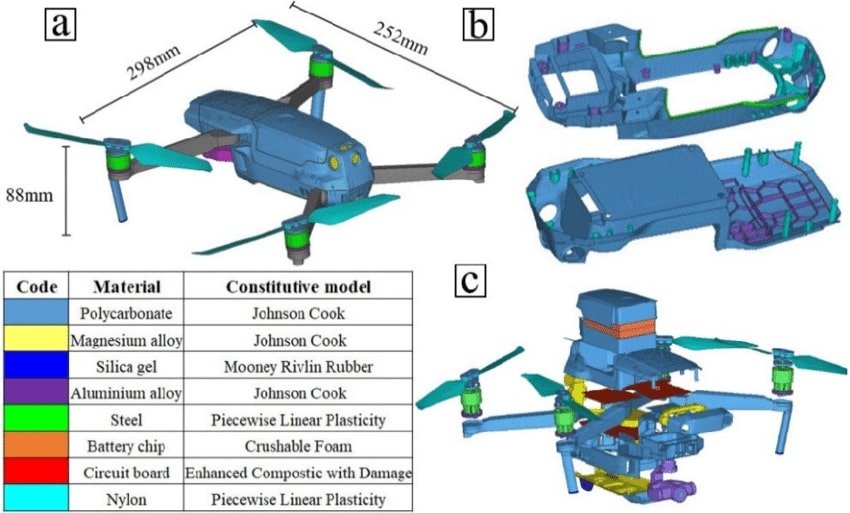
The relationship between materials and design is a foundational element in drone construction. Materials influence design choices, while design requirements often dictate the selection of materials. This interplay ensures that drones meet performance, durability, and efficiency goals while addressing specific operational needs. By understanding how materials and design work together, manufacturers can create drones optimized for a variety of applications, from recreational flying to industrial inspections.
The Influence of Materials on Drone Design
The properties of materials used in drone construction directly impact design decisions. Lightweight materials like carbon fiber or magnesium alloys enable streamlined, aerodynamic designs that reduce drag and enhance energy efficiency. Conversely, tougher materials like titanium may lead to bulkier designs that prioritize durability for high-stress applications.
For example:
- Carbon Fiber: Its exceptional strength-to-weight ratio allows for thin, rigid frames, enabling drones to maintain stability and agility without excessive weight. This makes it ideal for racing drones or long-range UAVs.
- Plastics and Composites: These materials’ flexibility and ease of molding allow for complex, aerodynamic shapes, which are commonly used in casings and housings for recreational or consumer drones.
- Aluminum and Magnesium Alloys: Their machinability and heat resistance influence designs that incorporate intricate components like motor mounts and heat sinks.
Designers must carefully balance the benefits of each material with the specific requirements of the drone, such as weight limits, payload capacity, and environmental conditions.
The Role of Design in Material Selection
Design requirements often drive the choice of materials, ensuring that the drone performs effectively in its intended role. For example:
- Payload Capacity: Delivery drones or those carrying cameras may require materials that balance lightweight properties with structural strength to support additional weight without compromising flight performance.
- Environmental Resilience: Drones operating in harsh conditions, such as high humidity or extreme temperatures, may require corrosion-resistant materials like titanium or treated aluminum alloys.
- Flight Efficiency: Aerodynamic designs benefit from lightweight, rigid materials that reduce drag, such as carbon fiber composites.
These design considerations influence not only material selection but also how materials are processed and integrated into the final structure.
Case Studies in Material-Design Interplay
- Racing Drones: Racing drones require materials that are both lightweight and impact-resistant to handle high speeds and potential collisions. Carbon fiber frames are paired with aerodynamic designs to maximize speed and agility, while reinforced components ensure durability during races.
- Industrial Drones: Inspection drones often operate in rugged environments, requiring durable materials like aluminum alloys for their frames. These materials are incorporated into modular designs, allowing for the easy replacement of damaged parts while maintaining overall structural integrity.
- Aerial Photography Drones: Stability is crucial for capturing high-quality footage. These drones use lightweight materials for their frames and employ balanced weight distribution to ensure smooth flight, even with heavy camera equipment.
Innovations Bridging Materials and Design
Advances in materials science and design technologies are further enhancing the interplay between materials and drone engineering. For example:
- 3D Printing: This technology enables designers to create custom parts using advanced polymers or composites, combining lightweight properties with tailored designs for specific tasks.
- AI-Assisted Design: AI tools can optimize designs by analyzing material properties and flight dynamics, ensuring the most efficient use of resources.
- Smart Materials: Materials that respond to environmental changes, such as temperature or pressure, are being integrated into drones for adaptive performance.
Why Material-Design Interplay Matters
The synergy between materials and design is what allows drones to achieve their full potential. By carefully considering how materials influence design—and vice versa—manufacturers can create drones that excel in functionality, reliability, and efficiency. Whether it’s a compact consumer drone or a heavy-duty industrial UAV, this interplay ensures that each component contributes to the drone’s overall success.
Innovations in Drone Materials and Design: Shaping the Future of UAV Technology
The rapid advancement of materials and design technologies is transforming the drone industry, enabling the creation of UAVs that are lighter, stronger, and more versatile than ever before. Innovations in materials science, coupled with breakthroughs in design processes, are driving this evolution, allowing drones to achieve unprecedented levels of performance and efficiency. Let’s explore the cutting-edge innovations that are redefining drone materials and design.
1. Lightweight Composite Materials
Recent developments in composite materials are making drones more efficient and adaptable. Composites such as carbon-fiber-reinforced polymers are now being enhanced with advanced resins and nano-fillers, resulting in materials that are even lighter and stronger.
Applications include high-performance drones where weight reduction is critical, such as racing UAVs and long-range drones. These composites also improve structural rigidity, enabling drones to maintain stability under high stress or turbulent conditions.
2. Graphene Integration
Graphene, a single layer of carbon atoms arranged in a hexagonal lattice, is emerging as a game-changer in drone materials. Its incredible strength, lightness, and electrical conductivity make it an ideal candidate for next-generation drones.
Graphene-enhanced batteries promise faster charging times and longer flight durations, while graphene-infused composites can create ultra-lightweight frames with superior durability. Though still in the experimental phase, graphene’s potential to revolutionize energy efficiency and material strength is undeniable.
3. Biodegradable and Sustainable Materials
As environmental concerns grow, the drone industry is exploring eco-friendly materials to reduce its ecological footprint. Biodegradable plastics and plant-based composites are being developed for use in disposable or single-use drones, such as those deployed for disaster relief or agricultural monitoring.
These materials are also being tested in recreational drones, where environmental impact is a key consideration for consumers. Sustainable materials not only align with global eco-conscious trends but also open doors to innovative applications in remote or sensitive environments.
4. 3D Printing and Additive Manufacturing
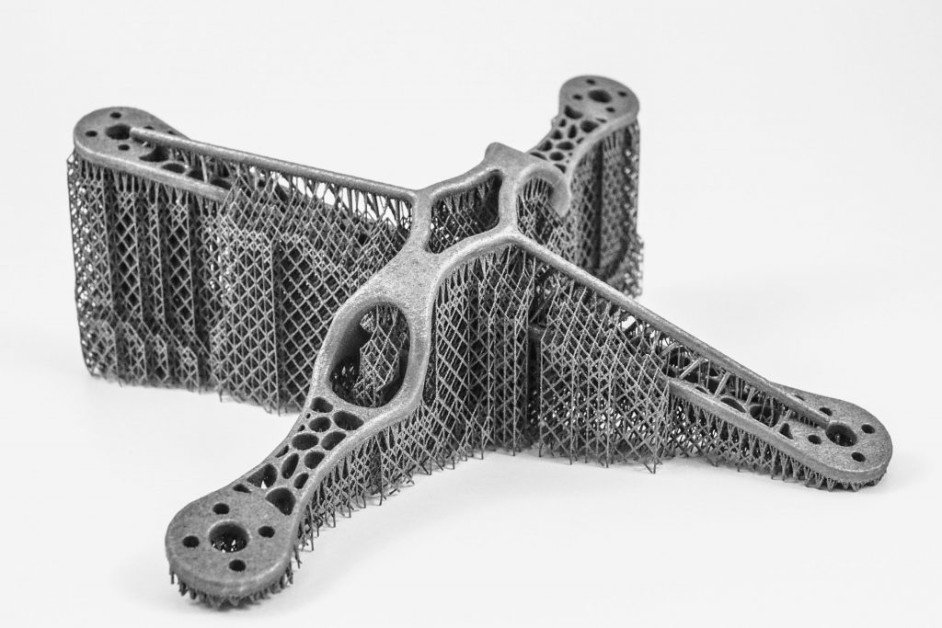
3D printing has revolutionized the way drone components are designed and manufactured. Using advanced polymers and composites, manufacturers can now produce custom parts with complex geometries that traditional methods cannot achieve.
This innovation is particularly beneficial for prototyping, enabling rapid iteration and testing of new designs. It also allows for on-demand production of replacement parts, reducing downtime and logistical costs for drone operators.
5. AI-Assisted Design
Artificial intelligence is playing a growing role in optimizing drone design. AI-powered tools analyze material properties, aerodynamics, and structural requirements to create highly efficient designs that maximize performance while minimizing weight.
Generative design, a subset of AI-assisted processes, uses algorithms to explore thousands of potential configurations based on specific constraints. This approach has led to the creation of innovative drone designs with optimized weight distribution, improved aerodynamics, and enhanced durability.
6. Smart Materials and Adaptive Components
Smart materials, which can change their properties in response to environmental conditions, are being integrated into drone design. For example, shape-memory alloys can adjust their form to enhance aerodynamics or protect sensitive components during impact.
Thermochromic coatings, which change color based on temperature, are being used to provide real-time thermal feedback, allowing operators to monitor heat buildup in critical components. These innovations improve performance and durability while enhancing safety during operation.
7. Modular and Customizable Designs
The trend toward modularity is reshaping drone design, allowing users to easily swap out components or adapt drones for specific tasks. This approach not only extends the lifespan of drones but also reduces costs by enabling upgrades rather than replacements.
Innovations in modular design are being paired with advanced materials to create drones that are lightweight, durable, and highly adaptable. Customizable payload systems and interchangeable parts make drones more versatile across a range of industries.
Why Innovations in Drone Materials and Design Matter
The innovations in materials and design are paving the way for drones that are more efficient, resilient, and sustainable. By leveraging cutting-edge technologies like graphene, smart materials, and AI-driven design, the drone industry is pushing the boundaries of what UAVs can achieve. These advancements are not only enhancing performance but also expanding the possibilities for drones in fields ranging from agriculture to disaster relief and beyond.
Practical Considerations for Consumers: Choosing the Right Drone
Selecting a drone involves balancing performance, functionality, and cost while ensuring the chosen model meets your specific needs. With so many options available, understanding the practical considerations behind materials and design can help consumers make informed decisions. From recreational users to professionals, each group has unique requirements that influence the choice of drone materials and design.
1. Assessing Purpose and Use Case
The first step in choosing a drone is understanding its intended purpose. Recreational drones prioritize ease of use and affordability, making lightweight materials like plastics and composites ideal. Professional drones, on the other hand, often require advanced features like longer flight times or higher payload capacities, which call for stronger materials such as carbon fiber or magnesium alloys.
For example:
- Photography enthusiasts may prioritize stability and precision, favoring drones with balanced weight distribution and rigid frames.
- Industrial users may require durability and modularity, favoring drones built with reinforced aluminum alloys or titanium.
2. Balancing Cost and Performance
The choice of materials significantly impacts the cost of a drone. High-performance materials like carbon fiber or magnesium alloys offer superior strength and weight advantages but come at a higher price. Consumers should evaluate whether these benefits justify the cost for their specific use.
For beginners or hobbyists, drones made with ABS plastics or composites can provide an affordable entry point without sacrificing basic functionality. Professionals who depend on drones for work may find it worthwhile to invest in premium materials that enhance durability and performance.
3. Understanding Material Trade-Offs
Each material used in drone construction has its pros and cons. For instance:
- Carbon Fiber: Offers unmatched strength-to-weight ratio but can be brittle and expensive.
- Plastics and Composites: Affordable and flexible but may lack durability under extreme conditions.
- Aluminum Alloys: Durable and lightweight but may not provide the same rigidity as carbon fiber.
Understanding these trade-offs helps consumers prioritize features that align with their needs. For example, someone operating a drone in windy conditions might prioritize stability and choose a model with a carbon fiber frame, while a casual user may opt for a plastic frame to save on costs.
4. Flight Time and Efficiency
A drone’s materials and design directly affect its flight time and efficiency. Lightweight materials reduce energy consumption, allowing for longer flights, while aerodynamic designs minimize drag. Consumers focused on extended use, such as aerial videography or surveying, should look for drones with optimized materials and design features that maximize energy efficiency.
5. Maintenance and Durability
Practicality extends beyond initial purchase decisions. Consumers should consider the long-term durability and maintenance requirements of their chosen drone. Modular designs made with durable materials like aluminum alloys or reinforced plastics can simplify repairs and reduce costs over time.
For professional users, drones with easily replaceable parts and strong frames can minimize downtime and ensure reliable operation in demanding environments. Recreational users may prefer drones with flexible materials that can withstand minor crashes and require minimal maintenance.
6. Environmental Factors
The operating environment plays a key role in determining the ideal materials and design. Drones exposed to harsh conditions, such as high humidity or extreme temperatures, require corrosion-resistant materials like treated aluminum or titanium. For drones used in coastal or marine environments, weatherproof casings and robust designs are essential.
Conversely, indoor drones or those used in controlled environments can prioritize lightweight and flexible materials to enhance maneuverability.
7. Future-Proofing and Upgradability
As technology advances, consumers should consider drones that offer upgradability and future-proofing. Modular designs enable users to adapt their drones to new technologies or changing requirements, such as adding improved sensors, cameras, or batteries. Investing in a drone with these capabilities ensures it remains relevant and functional for years to come.
Why Practical Considerations Matter for Consumers
Selecting the right drone involves more than just choosing a model; it’s about understanding how materials and design impact performance, durability, and overall value. By considering factors like purpose, cost, maintenance, and environmental suitability, consumers can find a drone that aligns with their needs and expectations.
The Future of Drone Materials and Design: Pioneering the Next Generation of UAVs
The future of drones lies in the seamless integration of advanced materials and innovative design principles. As technology evolves, the possibilities for drones are expanding, paving the way for UAVs that are more efficient, durable, and adaptable than ever before. Emerging trends in materials science, sustainability, and automation are reshaping the landscape of drone engineering, enabling breakthroughs that promise to revolutionize the industry.
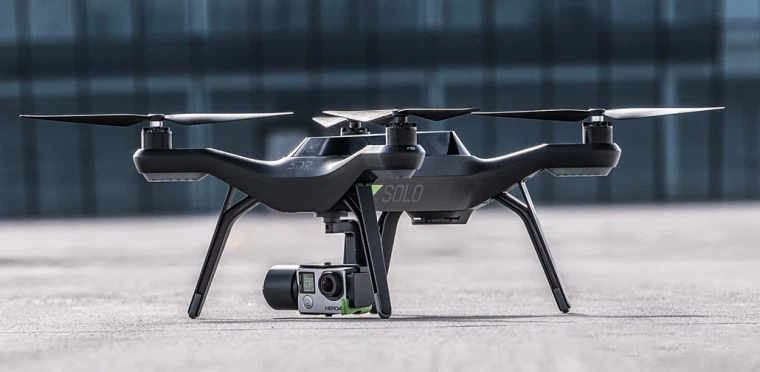
1. Advanced Lightweight Materials
The demand for longer flight times and greater efficiency is driving the development of ultra-lightweight materials. Innovations such as graphene-reinforced composites and carbon nanotubes are poised to redefine strength-to-weight ratios, allowing drones to carry heavier payloads while consuming less energy.
Nanotechnology is also playing a role in creating materials with enhanced properties, such as self-healing polymers that can repair minor damages autonomously. These advancements will make drones more resilient, reducing maintenance needs and extending operational lifespans.
2. Smart Materials for Adaptive Performance
Smart materials, capable of responding to environmental conditions, are set to become a key feature in future drone designs. Shape-memory alloys, for instance, can adjust their structure in response to temperature changes, optimizing aerodynamics or protecting components during impact.
Electrochromic materials, which change opacity with electrical input, may be used to create drones with adaptive camouflage for military or wildlife applications. These innovations allow drones to become more versatile and capable of operating in challenging environments.
3. Biodegradable and Eco-Friendly Materials
Sustainability is becoming a priority in drone manufacturing, with researchers exploring biodegradable materials for single-use or disposable drones. Plant-based composites and bioplastics offer an environmentally friendly alternative to traditional materials, reducing waste and ecological impact.
In addition to materials, sustainable design practices, such as modularity and recyclability, are being incorporated to ensure drones align with global efforts to minimize environmental harm.
4. AI-Driven Design Optimization
Artificial intelligence is revolutionizing the way drones are designed. AI algorithms can analyze material properties, flight dynamics, and structural requirements to generate optimized designs that maximize performance and minimize resource use.
Generative design, powered by AI, explores thousands of potential configurations to create drones that are lighter, stronger, and more efficient. This approach not only accelerates innovation but also ensures that drones are tailored to their specific applications with unparalleled precision.
5. Integration of Energy-Efficient Technologies
The future of drone materials and design will also focus on improving energy efficiency. Lightweight, energy-dense batteries made from advanced materials like solid-state electrolytes or graphene will enhance flight durations. Additionally, solar-powered drones incorporating flexible photovoltaic cells are expected to become more prevalent, especially for long-range and high-altitude operations.
Hybrid power systems that combine traditional batteries with fuel cells or thermoelectric generators are also being explored, enabling drones to operate for extended periods with reduced energy consumption.
6. Customization Through 3D Printing
Advances in 3D printing technology are making it easier than ever to create custom drone components tailored to specific needs. Future drones will leverage additive manufacturing to produce complex structures, reducing waste and allowing for on-demand production of replacement parts.
This capability will be particularly valuable in remote locations, where drones can be repaired or adapted on-site using portable 3D printers. The integration of advanced materials into 3D printing processes will further expand design possibilities.
7. Autonomous and Collaborative Designs
As drones become more autonomous, their materials and design will evolve to support advanced AI systems. Lightweight, vibration-dampening materials will enhance the performance of sensitive onboard sensors, while modular designs will enable drones to work collaboratively in swarms.
Future drones may also incorporate soft robotics principles, using flexible and adaptive materials to navigate complex environments like forests or urban areas.
8. New Frontiers in Aerospace Applications
The use of drones in aerospace applications is opening new opportunities for innovation in materials and design. High-altitude drones designed for atmospheric research or satellite deployment will require materials capable of withstanding extreme conditions, such as temperature fluctuations and high radiation levels.
Cutting-edge aerospace materials, including ceramic composites and metallic foams, are being explored to meet these challenges. These advancements will push the boundaries of what drones can achieve, expanding their role in space exploration and beyond.
Why the Future of Drone Materials and Design Matters
The evolution of drone materials and design will redefine the capabilities of UAVs, enabling them to tackle increasingly complex tasks with greater efficiency and sustainability. From eco-friendly materials that reduce environmental impact to AI-driven designs that optimize performance, these innovations will shape the next generation of drones.
As drones become integral to industries such as agriculture, logistics, and emergency response, the continued advancement of materials and design will ensure they remain versatile, reliable, and effective. The future of drones is not just about what they can do—it’s about how they are built to meet the challenges of tomorrow.
To Learn more about acronyms used in this article visit our Drones Acronym Page.




